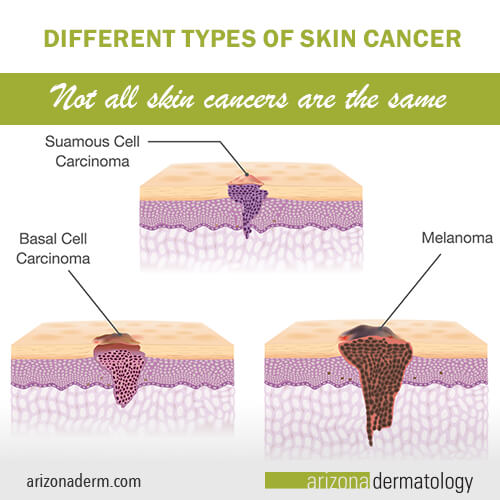 Not all skin cancers are the same. The most common types of skin cancer fall into one of three groups: basal cell carcinomas, squamous cell carcinomas, and melanomas. Let’s take a closer look at each.
Not all skin cancers are the same. The most common types of skin cancer fall into one of three groups: basal cell carcinomas, squamous cell carcinomas, and melanomas. Let’s take a closer look at each.
Basal Cell Carcinoma
The most common type of skin cancer, basal cell carcinoma, accounts for approximately 80% of all diagnosed skin cancers. About 4.3 million new cases of basal cell carcinoma are diagnosed each year.
Are basal cell carcinomas dangerous? Basal cell carcinomas are small, slow-growing,and don’t tend to spread to other areas of the body, so they are not generally dangerous. They do, however, need to be treated by a dermatologist. When caught early, basal cell carcinomas are easily cured and result in minimal physical damage or scarring.
What causes basal cell carcinoma? Basal cell carcinomas develop from abnormalities in the basal cells, round cells located in the lower epidermis. When ultraviolet light from the sun or tanning beds triggers changes in these cells, they begin to reproduce uncontrollably, resulting in a basal cell tumor.
What does a basal cell carcinoma look like? Basal cell carcinomas can look quite different from one person to the other. They may appear as an open sore, a red patch, a pink growth, shiny bump, or a growth with elevated, slightly rolled edges and a central indentation.
How are basal cell carcinomas treated? There are many options to treat small or early basal cell carcinomas in our office, including electrosurgery, Mohs surgery, excision, superficial radiotherapy (SRT), and cryosurgery. There are also topical chemotherapy and immunotherapy medications you can use at home. Once your diagnosis is confirmed, your doctor will discuss with you the best options to treat your basal cell carcinoma.
Squamous Cell Carcinoma
About 20% of skin cancer will be squamous cell carcinomas. Around 2% to 5% of these will spread to other parts of the body. Over a million new cases of squamous cell carcinoma are diagnosed in the U.S. every year.
Are squamous cell carcinomas dangerous? Most squamous cell carcinomas are curable when caught early, but if left to develop, lesions can become disfiguring, invasive, and even deadly. Many people are aware of the dangers of melanoma, but the latest figures from The Skin Cancer Foundation have revealed that over 15,000 people die of squamous cell carcinoma each year in the U.S., which is more than double the death rate for melanoma.
What causes squamous cell carcinoma? Squamous cell carcinomas develop when the DNA of the flat, scale-like squamous cells that make up most of the epidermis are damaged. Damage can occur from sun exposure, burns, chemicals or x-ray radiation.
What does a squamous cell carcinoma look like? Squamous cell carcinomas are usually found on sun-exposed areas of the body, especially around the mouth, but can also appear on the anus and genitals. Squamous cell carcinomas look different from person to person. They may appear as a scaly red patch, an open sore, a raised growth with a central depression, or rough, thickened or wart-like skin. They may crust over, bleed or itch.
How are squamous cell carcinomas treated? Depending on the tumor type, location, size and depth, as well as your age and health status, your dermatologist will recommend one of many options for treating a squamous cell carcinoma. These options include: excision, Mohs surgery, electrosurgery, cryosurgery, SRT, and topical medications. About 95% of squamous cell carcinomas are caught early, when they are most likely to be cured.
Melanoma
Melanoma is the most serious type of skin cancer, however, when detected early, the 5-year survival rate for melanoma is 99%. It is estimated that over 207,000 new cases of melanoma will be diagnosed in the U.S. in 2021.
What causes melanoma? Melanoma develops when ultraviolet exposure causes mutations in the melanocytes (pigment-producing cells) of the skin, resulting in uncontrolled growth. Many people believe that melanomas typically develop from an existing mole, but 70%-80% of melanomas are new growths.
How dangerous is melanoma? Melanoma is considered the most dangerous form of skin cancer because of its ability to quickly spread to other areas of the body if not treated early. It is estimated that over 7,000 people will die of melanoma in 2021.
What does melanoma look like? Melanomas vary from person to person. The best way to screen yourself for melanoma is using the ABCDE criteria, which evaluates the asymmetry, border, color, diameter and evolution of a mole. Look for any new, unusual or changing areas of your skin, both in sun-exposed and sun-protected areas. Be advised: melanoma can show up anywhere, even in places you’d least expect.
How is melanoma treated? Melanoma is typically treated with excision or Mohs surgery and is very curable if caught early. If the melanoma has spread, other options such as immunotherapy, targeted therapy, chemotherapy and radiation may be recommended. Revolutionary advancements in immunotherapy are improving survival rates and quality of life for people with advanced melanoma.
Other, rare skin cancers include:
- Merkel cell carcinoma (also called neuroendocrine carcinoma), a highly aggressive cancer that develops in the hormone-producing cells under the skin and in the hair follicles
- Sebaceous carcinoma, an aggressive skin cancer that usually develops on the lower eyelid
- Cutaneous T-cell lymphoma, a blood cancer that develops on the skin and looks like eczema or psoriasis
- Dermatofibrosarcoma protuberans, a slow-growing, very treatable cancer that develops in the middle layer of the skin (dermis)


